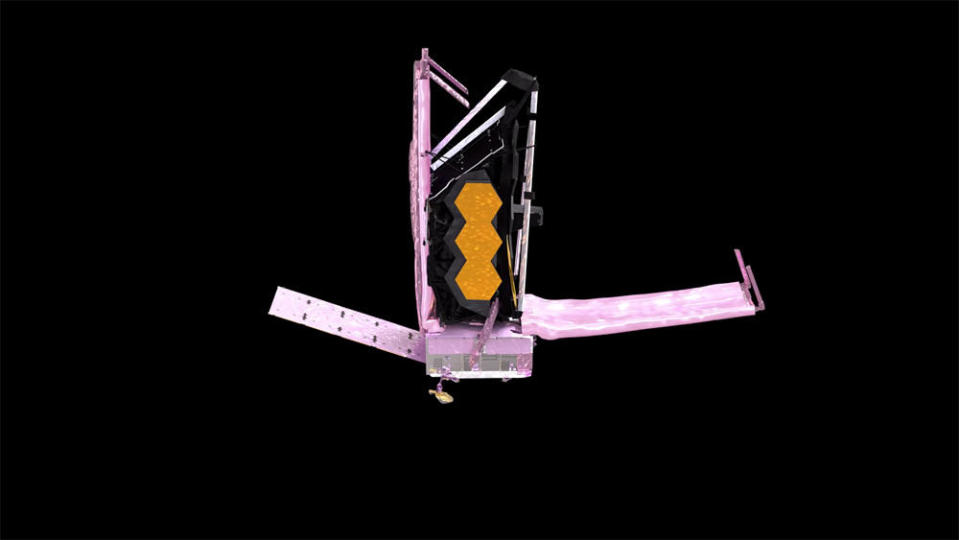Space telescope faces major test as sunshade deployment begins
Now well beyond the moon, the James Webb Space Telescope has begun a nail-biting series of steps to safely unfurl the observatory's fragile sunshield.
The five-layer sunshade, the size of a tennis court, is required to block out the sun and cool Webb's optics and instruments to within 50 degrees of absolute zero, or minus-370 Fahrenheit. Only then will the telescope be able to register the faint infrared light from the first generation of stars and galaxies.
Sunshade deployment is considered one of the riskiest aspects of the $10 billion mission, one that simply has to work as planned or Webb's science will be degraded. Extraordinary tests were carried out on the ground to make sure the deployment would work as planned, but there are no guarantees.

"You don't want to test it too much because the sunshield is so fragile, but we did three or four deployments and the last one, we were fully successful, we felt really good about it," Bill Ochs, NASA's project manager, said before launch. "It only has to work one more time, and that's in orbit."
The sunshade was carefully folded up before launch and the two pallets holding its Kapton membranes, all pinned in place, was rotated upward against the body of the spacecraft to fit inside the nose cone of its Ariane 5 rocket.
On Tuesday, three days after the Christmas Day launch and following two flawless trajectory correction thruster firings, commands were uploaded to rotate the first pallet back down on the forward side of Webb's primary mirror. The second pallet was successfully rotated into place on the aft side of the mirror later in the day.

"The deployment of the pallet structures begins what will be at least five more days of necessary steps to deploy the sunshield, a process that will ultimately determine the mission's ability to succeed," NASA said in a blog post.
"If the sunshield isn't in place to keep Webb's telescope and instruments extremely cold, Webb would be unable to observe the universe in the way it was designed."
Assuming no problems with the pallets, a motorized tower will be extended Wednesday, raising Web's mirror and instrument assembly 48 inches away from the spacecraft's support section, or bus. That will isolate the optics from the heat generated by electronic gear positioned below the sunshade on the "hot side" of the spacecraft.
With the sunshade pallets already deployed fore and aft of the extended optics assembly, launch restraints will be released Thursday and protective covers rolled back out of the way to either side of the folded sunshade membranes.
Then, on New Year's Eve, two telescoping booms at right angles to the pallets will be commanded to extend, pulling the stowed membranes out into a roughly kite-like shape. To get that far, 107 actuators will have had to work exactly as planned to pull out pins holding the sunshade's layers and covers in place.
Over the next two days, motor-driven cables running through dozens of pulleys will be tightened, separating the layers and pulling them taut, ensuring a slight gap between each layer to allow heat to radiate outward to the sides.
If all goes well, the sunshade will be fully deployed and tensioned by January 2.
"The sunshield alone has 90 cables in it, that if you strung them end to end would be almost a quarter mile in length," said Paul Geithner, a deputy project manager. "And that's for pulling out the membranes and tensioning them. ... And, of course, we have 107 little non-explosive actuator devices, membrane release devices, that basically pin the membranes down and the covers over them for launch."
The sun shield layers are made up of "floppy" membranes, "and they'll just float around in zero G (gravity) and you'll get a tangled mess if you don't ... control them as much as possible," he said.
"And so we have many little devices to constrain and ensure that all these cables and membranes and such don't just flop around randomly and snag on something. That's just where so much of the deployment risk is because it's a lot of parts. They're simple mechanisms, but there are a lot of them, and they all have to work."

After the sunshade is fully unfurled, flight controllers will turn their attention to Webb's primary and secondary mirrors to complete the post-launch deployment sequence.
On January 4, the telescope's secondary mirror, mounted at the apex of a folded-up tripod assembly, will robotically extend, positioned to send light back down to instruments mounted directly behind the 21.3-foot-wide primary mirror.
Made up of 18 hexagonal segments, the primary mirror was too large to fit inside the Ariane 5's nose cone. So six segments, three on each side, were folded back out of the way for launch.
Starting around Jan. 6, the two wings will be unfolded and locked in place to complete Webb's major deployments.
Webb is expected to reach its orbital parking place a million miles from Earth 29 days after launch, or around January 23. But it will take another five months or so to precisely align Webb's mirror segments and to check out and test the telescope's instruments before the first science images are released.
Arizona students do good deeds for hospice patients

